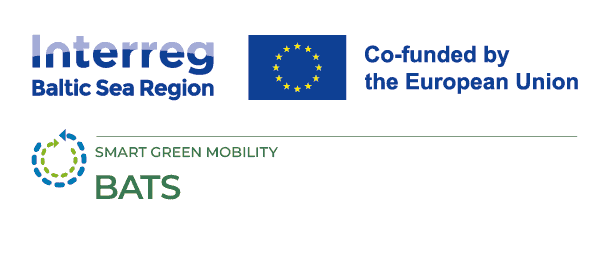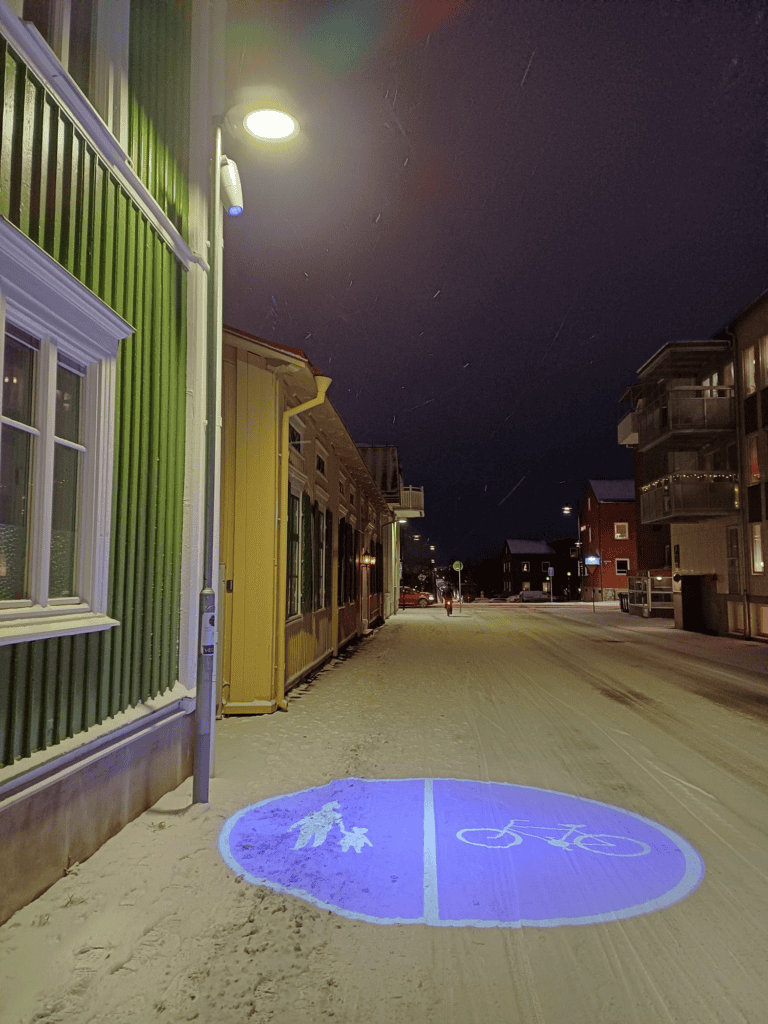
Developing a Citizen Activation Guide for year-round active mobility
18 December 2024
The BATS Citizen Activation Guide (CAG) is a comprehensive framework designed to help city planners, local authorities, and community organisations promote Year-Round Active Mobility (YRAM) by systematically engaging citizens. The guide aims to foster a sustainable, health-conscious community through informed planning and strategic citizen involvement. It provides practical steps for planners to maintain active mobility year-round, especially during colder and darker months.
The first draft of the Citizen Activation Guide is expected in Spring 2025. However, as several pilot activities have already commenced within the BATS project, the concepts of the citizen activation guide are being explored in all the seven cities. In this article, we will take a closer look at the engagement activities carried out across the BATS pilot cities in recent months.
Klaipeda
Experiment: Instalment of lighting projectors to cycle paths to enhance user safety and ensure access to year-round active mobility.
Klaipeda’s engagement plan consists of launching a comprehensive PR campaign and releasing an official statement. While the main target groups of this activity are municipal decision makers, seasonal cyclists, students, and commuters, the goal is also to influence regional, national and international institutions. Municipal decision-makers are seen as key stakeholders for this pilot and engagement, as they have the greatest influence on shaping city plans and sustainable mobility policies.
In order to effectively reach the identified key stakeholder groups, Klaipeda plan to utilise social media, newsletters, and events featuring decision makers, with the main message to assure cyclists that the improved infrastructure is safe to use in all-season conditions.
Kalundborg
Experiment: Instalment of barriers, improved parking facilities close to shops and schools, and to offer safe covered bike parking with charging in the city centre. The aim of Kalundborg’s activities is to improve public health, reduce traffic congestion, lessen the need for expensive and space-consuming parking facilities, reduce energy consumption for personal transport, and lower CO2 emissions.
The team will conduct a local survey aimed at increasing planners’ knowledge of citizens’ specific commuting experiences and needs, while also raising awareness among citizens about the opportunities for cycling to and from work and education facilities. In order to activate citizens and ensure effective broadcast of the planned pilot activities, Kalundborg Municipality will run campaigns in local media, on company websites, and social media, as well as forming agreements with local businesses and involving students as local ambassadors, distributing surveys during breaks to drive completion rates.
Furthermore, to confirm the effectiveness of the various campaigns, Kalundborg Municipality will conduct traffic measurements, hold meetings with managers and decision-makers in businesses and educational institutions to discuss how they can collaboratively encourage more people to cycle to and from work and education.
Porvoo
Experiment: Interactive 3D modelling of a planned active mobility bridge to enable experiencing the accessibility differences between existing and planned routes, especially in winter conditions. Introduction of a winter agent program to improve winter maintenance on walking and cycling routes by engaging citizens through manual and app-assisted data gathering.
The Porvoo team is aiming to engage stakeholders by inviting them to try out the interactive model being piloted locally, with politicians and citizens being initially targeted through a targeted social media campaign.
Learnings will also be taken from other BATS partner cities including Gdynia and Hamburg, as both cities have previous experience in testing 3D modelling. With regards to the Winter Agent Programme, Finland is quite mature in testing of this nature, with previous trials previously run in cities throughout the country. This testing has shown that citizens of Porvoo are generally quite active when compared to other cities.
Kiili (HOL)
Experiment: Intervention in the local school to encourage students and staff to cycle and walk to school, rather than continue the existing reliance on cars.

The intervention run in Kiili by BATS partner Region of Harju County Municipalities (HOL) is mainly targeted towards students, however there is an additional aim to influence recreational athletes, middle-aged citizens, and preschool children. Through the activities, the team also hopes to ensure that cycle and walking paths are maintained appropriately for local elderly people to make use of them throughout the year.
In order to reach these local citizen groups, the HOL team is utilising social media, the local newspaper, personal interviews, posters, and outdoor advertising. Additionally, they plan to organise community events to promote the proper use of pedestrian and bicycle routes, cycling days, and pedestrian challenges such as step competitions. Through these methods, the team hope to establish channels for resident feedback on the design and use of cycle routes, while highlighting the environmental benefits of adopting cycling as a year-round transport option.
So far, the interaction with the BATS project has resulted in the local school counting the number of bikes parked outside on a daily basis as a means to assess current active mobility statistics, while in order to encourage students to continue using their bikes throughout the winter, a winter bicycle repair workshop is being planned. To further deepen their knowledge and understanding of the current statistics behind active mobility, the team are planning to run surveys and utilise digital platforms to collect key information.
Umeå
Experiment: Activities throughout the BATS project in the Swedish city of Umeå are focused on lighting, loan of electric bicycles, winter scouts, European Mobility Week 2024, and test travellers to reduce car use in the city & increase the share of walking and cycling with a focus on wintertime.

Local men who commute to work, usually by car, have been identified as the main target groups through research including travel surveys and mobility data analysis. For this reason, communication is aimed at male-dominated workplaces, with Umeå being one of the few locations to have a specific target group, in Umeå it is male commuters.
Communication channels being strategically used in this context are social media, radio, commercial, workplace communication channels, joint networks of companies or organisations, and citizen dialogues. Through these channels, the team have been able to showcase the active work being done on sustainable mobility while disseminating the benefits and opportunities for travelling sustainably, particularly during winter. In order to stimulate the number of local active mobility users, the team are providing YRAM essentials including seat covers, helmets, mittens, hats, and thermos flasks.
Additionally, Umeå Municipality encourages sustainable mobility choices across the city by establishing several partnerships with transport providers, including the possibility for citizens to enjoy the benefit of a free monthly bus pass if they give up the use of their car for the month. In terms of active mobility, they work with e-bike companies and organisations to run competitions within schools to promote active transport choices. Feedback is commonly collected through surveys and focus groups, with the team able to analyse changing mobility behaviour through analysis of feedback and statistics.
Gdynia
Experiment: Promoting YRAM in kindergartens with campaigns in 54 schools and kindergartens. The current campaign is focused on wintertime active mobility and lasts until 20th December. Specifically, the Gdynia team is targeting children aged between 4-7 years, as well as their parents. Additionally, they have been selecting the most active kindergartens and primary schools who already took part in mobility campaigns earlier in the year.

The main communication method is directly via teachers, but also social media, the city website, and posters. The communication strategy is placing more emphasis on active mobility throughout the whole year. In a campaign run in early autumn, 630 children participated, and the challenge for Gdynia is to convert this high level of participation during winter months. One way the team are trying this is by partnering with Gdynia Sport, the city unit responsible for sports events and education campaigns. This partnership has resulted in the distribution and promotion of campaign materials amongst kindergartens and primary schools across the region.
In order to target other groups, Gdynia is also thinking of how to encourage 16-19 year old children, many of whom are obtaining a driving license and thus shifting their preference towards the use of a car, rather than active mobility modes.
Hamburg
Experiment: In the German city of Hamburg, the Altona district is facilitating the introduction of protective elements on streets to separate bicyclists from cars. These activities are aimed at improving safety perceptions, thus encouraging an uptake of year-round active mobility.
The team is targeting all current and potential active mobility users between the ages of 8-80 through a variety of communication channels. These channels include emails, social media, in-person events, PR workshops and campaigns. The main messages to be conveyed to local citizens include the benefits of year-round active mobility, and the new possibilities as a result of recent improved safety infrastructure. The Hamburg-Altona team is keen to promote active mobility as a healthy, quick, sustainable mode of transport all year round.
To ensure the activities are targeted and implemented effectively, the Hamburg-Altona team is collecting feedback using a mixture of methods, including focus groups and on-site interviews before and after the implementation of any intervention. The main focus is the analysis of perceived safety aspects, as the team want to ensure cyclists feel safe and confident while enjoying active mobility transport options.





